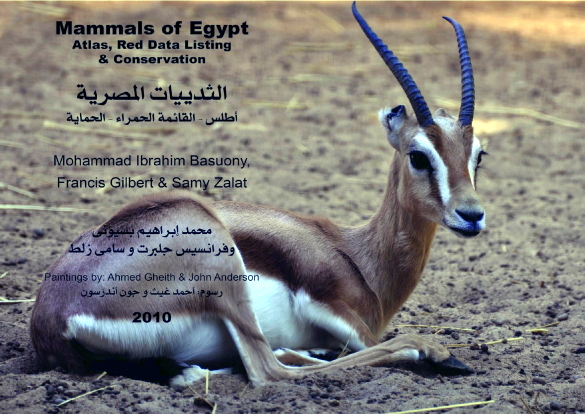Mammals of Egypt: atlas, Red Data listing and conservation
There are 110 species of mammals recorded from Egypt. The 93 terrestrial species are reasonably well known, but the marine mammals are very poorly known with at least 17 recorded species.
Seven taxa are endemic to Egypt: five species) Flower’s Shrew, Egyptian Pygmy Shrew, Flower’s Gerbil, Pale Gerbil and Egyptian Weasel) and two subspecies (Nile Swamp Cat, Egyptian Barbary Sheep).
There are five main hotspots of mammal diversity in Egypt:
- the lower Nile Valley and Delta,
- the Mediterranean coast, especially west of the Nile,
- the Qattara depression, one of the great unexplored areas of Egypt,
- the Gulf of Suez area: around Suez and Ras Sidr on the eastern shore, the Suez Canal region near Ismailia, and the northern Red Sea coast, especially around Hurghada and Shalatein,
- the St Katherine Protectorate.
From the point of view of mammal diversity, the existing network of Protected Areas does not seem adequate for future conservation require-ments. New Protected Areas will be needed in the lower Nile Valley, along the north coast between Alexandria and Salloum, the northern part of Gulf of Suez and perhaps in the Qattara depression.
With respect to the Egyptian Investment plan (1997-2017) for land use in Egypt, it is obvious that Siwa is threatened by all four of the major elements of the 2017 plan (urban, agriculture, tourism & mining); the Mediterranean coast is seriously threatened by three elements (urban, tourism & agriculture); the Red Sea coast and Gebel Elba are threatened by two elements (tourism and mining).
In our opinion, the areas planned for tourism on the Mediterranean north coast represent the major threat to mammal biodiversity in Egypt.
This assessment provides an agenda for action by decision-makers, rangers and scientists:
- decision-makers need to act to conserve endangered species, and to fund the studies of the species named below so as to deter-mine their needs;
- rangers need to use this book as a stimulus to record the mammals of their Protected Area in much greater detail than in the past; in the relevant PAs they should conduct population studies to provide the data needed to assess the specified species; they should concentrate effort on the species listed below;
- scientists need to conduct the right studies on the right species in the right way, so as to identify the critical population status and ecological attributes that will enable effective conservation measures to be taken.
The 17 relevant species for action are:
- Egyptian Barbary Sheep Ammotragus lervia ornatus
- Slender-horned Gazelle Gazella leptoceros
- Wild Ass Equus asinus
- Egyptian Weasel Mustela subpalmata
- Four-toed Jerboa Allactaga tetradactyla
- Egyptian Mole Rat Spalax aegyptiacus
- Shaw’s Jird Meriones shawi
- Negev Jird Meriones sacramenti
- Flower’s Gerbil Gerbillus floweri
- Anderson’s Gerbil Gerbillus andersoni
- Fat-tailed Jird Pachyuromys duprasi
- Mackilligin’s Dipodil Dipodillus mackilligini
- Simon’s Dipodil Dipodillus simoni
- Sinai Barbastelle Barbastella leucomelas
- Fairy Pipistrelle Hypsugo ariel
- Flower’s Shrew Crocidura floweri
- Egyptian Pygmy Shrew Crocidura religiosa

My contribution:
Mapping, species istribution models, translation, and Red Data assessments. I also helped in the analyses and editing.